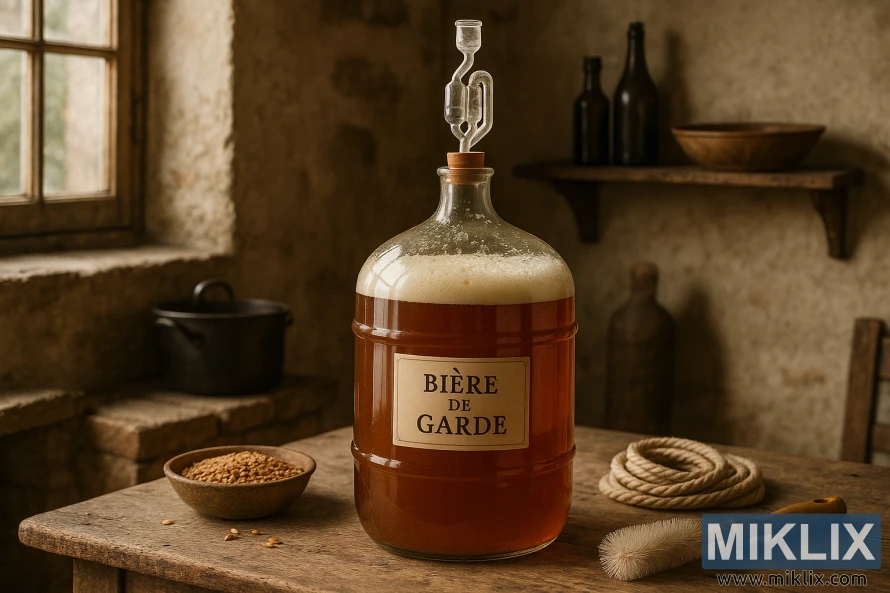Image: Bière de Garde Fermenting in a Rustic French Farmhouse
Published: October 21, 2025 at 7:23:19 AM UTC
A traditional French farmhouse brewing scene with Bière de Garde fermenting in a glass carboy, surrounded by grains, tools, and rustic decor.
The image depicts a rustic French homebrewing setting, showcasing the fermentation of a traditional Bière de Garde. At the center of the composition, sitting prominently on a weathered wooden table, is a large glass fermenter, also known as a carboy. The fermenter is filled nearly to the shoulder with a deep amber-colored beer in mid-fermentation. A dense, creamy foam head—known as krausen—rests atop the liquid, hinting at the vigorous activity of yeast as it consumes sugars and releases carbon dioxide. Sealed into the narrow neck of the glass vessel is a rubber stopper fitted with an S-shaped airlock, partially filled with liquid, which allows gas to escape while preventing outside air and contaminants from entering. The fermenter bears a cream-colored paper label with bold black lettering: Bière de Garde, making clear the traditional French farmhouse ale undergoing transformation inside.
Natural light streams in softly through an old, paned wooden window on the left side of the image, illuminating the golden hues of the fermenting beer and highlighting the textures of the rustic room. The light falls at a low angle, producing gentle shadows that add depth and atmosphere. The table, rough with years of use, hosts a number of objects associated with brewing: a shallow wooden bowl filled with cracked malted barley grains, a length of coiled hemp rope, and a wooden-handled cleaning brush with stiff white bristles, suggesting the preparatory and maintenance tasks involved in homebrewing. A few stray grains have spilled onto the table, reinforcing the sense of a working space rather than a staged scene.
In the background, the stone walls of the room and the simple furnishings evoke the character of a traditional French farmhouse. A narrow wooden shelf mounted against the wall holds two dark glass bottles—perhaps intended for conditioning and storing the finished beer—and a wooden bowl with a hand-carved appearance. Further back, the soft silhouette of an old bottle or demijohn rests on the floor, blurred slightly into shadow, enhancing the lived-in feel of the environment. On the left, the thick stone windowsill supports a black cast iron pot, another reminder of the domestic, pre-industrial setting in which farmhouse brewing traditions developed.
The overall atmosphere of the scene is warm, earthy, and timeless, capturing both the craft of brewing and the environment in which this beer style historically thrived. Every element—the light, the aged surfaces, the functional objects, and the beer itself—contributes to an evocative tableau that blends authenticity with artistry. The viewer can almost imagine the faint bubbling within the fermenter, the aroma of malt and yeast, and the anticipation of a rich, malty beer designed for long keeping. This image not only documents a stage of the brewing process but also pays homage to the cultural and historical heritage of Bière de Garde, a beer style rooted in northern France and celebrated for its rustic charm and enduring character.
The image is related to: Fermenting Beer with Wyeast 3725-PC Bière de Garde Yeast

